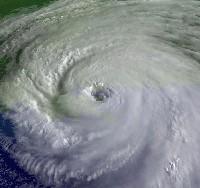Floodwall failure linked to about 600 deaths
By John Simerman, Dwight Ott and Ted Mellnik
December 30, 2005
NEW ORLEANS -- Nearly 600 people who died because of Hurricane Katrina might have survived had floodwalls on two New Orleans canals not collapsed, according to a Knight Ridder analysis of where bodies were found after the storm.
The bodies of at least 588 people were recovered in neighborhoods that engineers say would have remained largely dry had the walls of the 17th Street and London Avenue canals not given way after the height of the storm.
In contrast, 286 bodies were recovered in the Lower Ninth Ward, New Orleans East and neighboring St. Bernard Parish, where Katrina's storm surge poured over levees and flooded neighborhoods.
The role of the 17th Street and London Avenue canal floodwalls in the destruction of New Orleans has been hotly debated in the four months since the storm. Engineers who are investigating their collapse think that floodwaters generated by Katrina never rose high enough to pour over the walls, and they blame flawed design, construction or maintenance for the walls' failure and the flooding that followed.
Louisiana authorities are investigating whether laws were broken during construction of the floodwalls, but until now there's been no attempt to quantify how much their failure may have contributed to New Orleans' death toll.
Louisiana State University hurricane expert Ivor Van Heerden said there was no doubt that vast areas of the city would have remained dry, and residents relatively unscathed, had the walls of the 17th Street and London Avenue canals not collapsed.
Asked in an e-mail whether the majority of the city would have stayed largely dry had those floodwalls held, Van Heerden replied: "A big yes."
Peter Nicholson, an associate professor of civil and environmental engineering at the University of Hawaii, said some flooding in central New Orleans came from breaches on the west side of the Industrial Canal, but that those breaches were above sea level and the flooding stopped as Katrina's surge died down Aug. 29.
"The big difference is with 17th Street and London the breaches opened gaps that were below sea level and continued to drain Lake Pontchartrain until they were closed," Nicholson said.
This confounded rescue efforts and left thousands stranded in darkened hospitals, attics, on freeway overpasses or in the foul refuges of the Superdome and the convention center.
Dr. Frank Minyard, the Orleans Parish coroner, has estimated that 20 percent of Katrina's victims drowned. Scores more died awaiting rescue, trapped by floodwaters. The causes of death for many will never be known because their bodies were too badly decomposed by the time they were recovered.
Months after Katrina's landfall, experts are still debating how the tragedy might have been avoided. Local officials ordered an evacuation of New Orleans, but perhaps not soon enough. Tens of thousands of residents ignored the evacuation order. Federal help came slowly.
Debate also continues over what part Louisiana's fractured system for governing the levees played in the flooding. In addition to the two canals whose floodwalls collapsed, engineers reported poor maintenance and construction practices at scores of places throughout the vast levee system.
Louisiana officials are still tabulating the death toll, which stands at nearly 1,100 statewide. Dr. Louis Cataldie, the state medical examiner, said a precise total might never be known.
The Louisiana Department of Health and Hospitals, in response to a request from Knight Ridder, released a list this month of nearly 600 locations where at least 874 bodies had been recovered in Orleans and St. Bernard parishes, the two areas in Louisiana that Katrina hit the hardest.
Louisiana health officials say the list is incomplete, and a review of the data showed some inaccuracies.
But the addresses provided the first comprehensive view of where Katrina's New Orleans victims were found and allowed a systematic look at the dead for the first time.
The addresses showed that far more dead were recovered in western and central New Orleans than in the city's eastern neighborhoods, even though the Lower Ninth Ward, New Orleans East and St. Bernard Parish received the storm's harshest battering.
Van Heerden, the LSU hurricane expert, said the flooding in the eastern areas began shortly before the storm made landfall at 6:10 a.m. - an 18-foot storm surge from Lake Borgne destroyed much of the earthen levee system that had protected St. Bernard Parish. Most of the parish's 123 victims drowned in their homes, said Dr. Bryan Bertucci, the parish coroner.
By 6:30 a.m., water as high as 17 feet surged into a convergence of two channels east of New Orleans, engineers believe. It overwhelmed the levees, added to the flooding in St. Bernard Parish and began to flood the Lower Ninth Ward.
Just before 7 a.m., water poured over the top of the Industrial Canal, separating the Lower Ninth and New Orleans East from the rest of the city. The water eroded the back side of the levee, scouring out trenches that undermined the walls.
About 7:45 a.m., walls protecting the Lower Ninth were "explosively breached," and a head of water almost 20 feet high mowed down houses in its path, Van Heerden said.
But Van Heerden's re-creation of the storm's flooding indicates that as the storm's eye moved north to the south shore of Lake Pontchartrain, the surge that had buried St. Bernard Parish leveled off.
Most of central and western New Orleans remained dry - until the 17th Street and London Avenue canals' floodwalls collapsed.
Van Heerden, the deputy director of LSU's Hurricane Center, places the collapse of the 17th Street Canal wall at about 10:30 a.m., though others have reported it hours earlier. The breach would expand to 455 feet. The water overran the upscale Lakeview neighborhood and gradually filled the city.
At the London Avenue Canal, the 11-inch-thick concrete floodwalls bowed and then breached on both sides, at about 9:30 and 10:30 a.m. The two breaches measured 425 and 720 feet, according to the Army Corps of Engineers.
In central New Orleans, the water rose at different times, speeds and heights, depending on the neighborhood, and often the street. Water didn't reach some areas until the next day. It leveled off two days after the storm.
New Orleans police Sgt. Forrest Austin's mother, Winona Austin, 82, might have lived through the storm if water from the London Avenue Canal hadn't inundated her home in the Gentilly neighborhood.
"I got a guilty feeling because I didn't grab her by the arm and drag her out," he said. His mother's body wasn't recovered until three weeks after Katrina.
Arthur Batieste Jr., 78, a retired truck mechanic, rode out the storm with others at Second Mount Bethel Baptist Church. Then he went back to his home on Toledano Street, west of the Superdome. Water from the 17th Street Canal reached there early the day after the storm, rising eventually to 9 feet. Batieste's body was found two weeks later outside his house.
"I talked to him [that] Monday from the church on his cell phone a few times. He didn't tell me he was going back," said his daughter, Sharrell Irvin. "I guess people thought it was OK."
John Simerman and Dwight Ott, reporting from New Orleans, and Ted Mellnik, reporting from Charlotte, N.C., write for Knight Ridder newspapers.







1 Comments:
I've been down in the Lower 9 at the levee breaks 5 times in past two weeks....I would pretty much bet there are more bodies under that mess. You just have to see it to believe it.
Post a Comment
<< Home